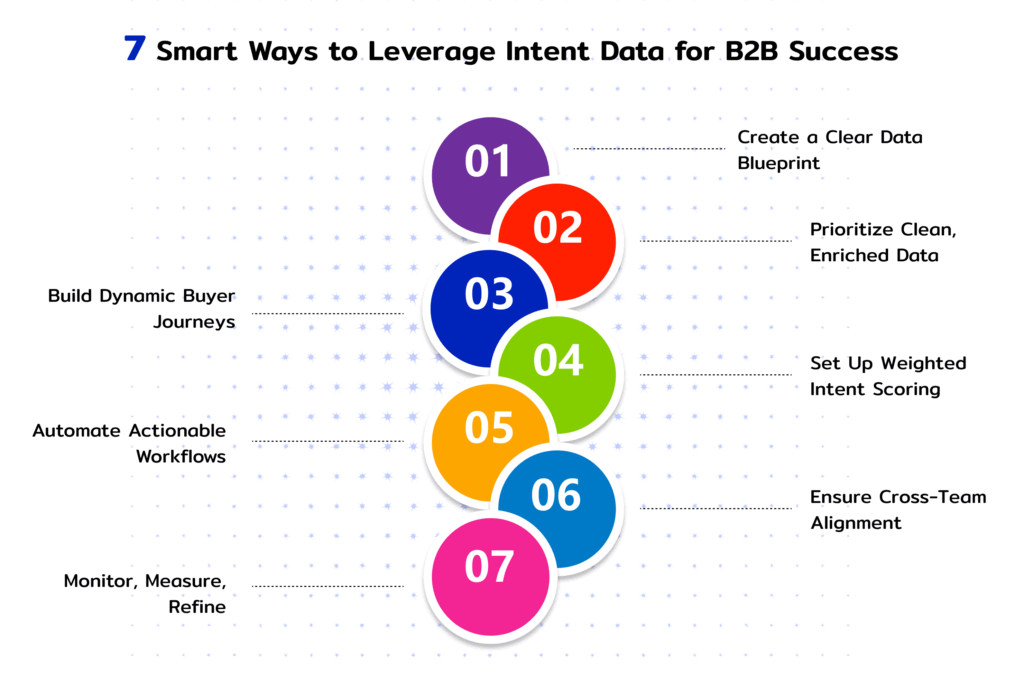In order to succeed in the competitive B2B landscape today, one needs more than just data, they have to leverage it proficiently. Failing to connect your Intent Data Bank to your activation systems will cause you to lag behind sharper, quicker competitors. With the right integration, pulled fragments of intent can work in unison and churn out revenue.
To make that easier for you, let’s discuss some ways to achieve the mentioned goal.
1. Start With a Clear Data Blueprint
The integration of different systems in the absence of a coherent strategy can lead to chaos. Identify where every intent signal emanates from, like content downloads, ad clicks, and webinars, in addition to participation and document where each fragment is applicable. Without an actionable plan, the integration of your Intent Data will proffer no value and will remain cluttered.
2. Prioritize Clean, Enriched Data
The intent insights a data offering provide will always be weighted based on the form of data offered. Remove duplicates present in records, check firmographic details, and fill in the blanks. Cleaner data enhances precision in lead scoring, targeting, and personalized campaigns, improving overall performance.
3. Build Dynamic Buyer Journeys
Use of static nurture tracks is obsolete. Instead, utilize intent insights to construct adaptable journeys that evolve with real-time interactions. For instance, if a lead suddenly exhibits heightened engagement with a particular product, immediately place them on a high-activity intent nurture path that includes product demos and in-depth case studies.
4. Set Up Weighted Intent Scoring
There exist varying degrees of action relevance. Lower-level activities such as reading a blog should be placed under low intent while requesting pricing information is deemed as high intent. Based on behavior and frequency of actions performed, assign weighted scores. Effective models ensure optimal prioritization and accelerated sales outcomes.

5. Automate Actionable Workflows
Create automation rules that react instantly to intent signals with your Intent Data Platform. For example, if a prospect’s score increases by 20% within a week, automatically place them in a personalized outreach campaign or notify the sales representative assigned to that prospect for immediate escalation.
6. Ensure Cross-Team Alignment
When utilizing intent data, marketing and sales are required to function in tandem. Set up collaborative review sessions so everyone is on the same page regarding definitions, scoring systems, and follow-up action expectations. With a synchronized approach to intent insights, which translates into tracking wins, helps achieve faster, more consistent outcomes.
7. Monitor, Measure, and Refine
Successful businesses practice upmost improvements. Optimize important metrics like conversion rate, revenue-driving deals, and influenced revenue. Monitor which intent signals are associated with closed-won deals and revise your strategies every quarter to improve results over time.
Conclusion
Being skilled at leveraging an Intent Data Bank in conjunction with the marketing systems is more than just integrating it—it’s crafting a sophisticated yet agile machine that enables the capture of potential buyers at the optimal moment during their buying journey. It is easy to forecast real growth when intent signals are thoughtfully crafted along with strategic innovation discipline. Today’s modern B2B sales environment rewards first movers who utilize clever tactics.
For More Information:
Selecting the Best Intent Data Platform for Your Account-Based Marketing Strategy
How to Pick the Ideal Intent Data Platform for Account-Based Marketing
Choosing the Right Intent Data Platform for Effective Account-Based Marketing
A Guide to Choosing the Best Intent Data Platform for ABM
How to Find the Perfect Intent Data Platform for Account-Based Marketing Success
Key Factors to Consider When Choosing an Intent Data Platform for ABM
This post was created with our nice and easy submission form. Create your post!





